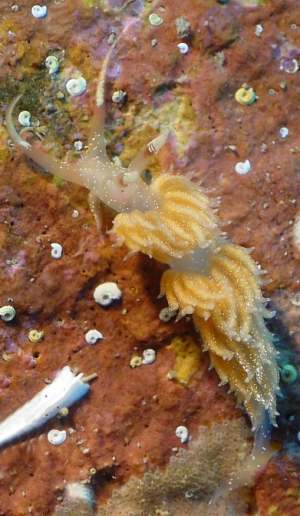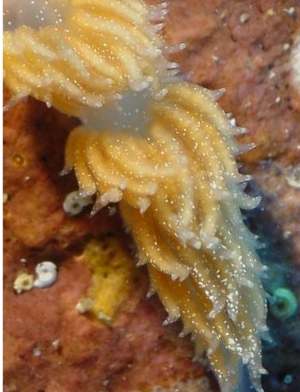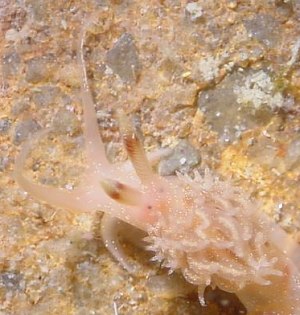
Facelina annulicornis
(Chamisso & Eysenhardt, 1821)
Order: NUDIBRANCHIA
Suborder: AEOLIDINA
Family: Glaucidae
DISTRIBUTION
Known from western mediterranean, Atlantic coast of France, southern British Isles.
PHOTO
Cerbere, France, Mediterranean coast, July 11, 2003, Depth: 9m, Size: 15mm. Photo: Marina Poddubetskaia
Grows to about 40mm long. Body has a pinkish tinge, usually more intense on the head. White spots are sprinkled over body and cerata. Rhinophores with 18 or more obliquely sloping lamellae. It has often been identified as F. punctata (Alder & Hancock,, 1845), but that is considered as synonym by Thompson & Brown, 1984.
Reference:
• Thompson, T.E. & Brown, G.H. (1984) Biology of Opisthobranch Molluscs, Vol 2. Ray Society: London.
Rudman, W.B., 2000 (July 18) Facelina annulicornis (Chamisso & Eysenhardt, 1821). [In] Sea Slug Forum. Australian Museum, Sydney. Available from http://www.seaslugforum.net/find/faceannu
Related messages
Facelina annulicornis from Guernsey
August 28, 2003
From: Richard Lord


Dear Bill:
I think the species in the attached photos is Facelina annulicornis. I would appreciate your confirmation. This specimen was collected by crab potter Clive Brown on August 2, 2003 from his crab pots off the south coast of Guernsey, English Channel.
YOu asked me in a response to a previous photo submission whether crab pots accidentally caught opisthobranchs. Clive and I believe that the occurrence of opisthobranchs in his crab pots is not accidental. After a season in the sea the lobster and crab pots are home to bryozoan, hydroid and ascidean colonies. We believe that the opisthobranchs somehow find the crab pots to feed and lay their eggs.
Best Wishes,
Richard Lord
fishinfo@guernsey.net

Dear Richard,
I agree with you identification. The photo alongside shows the morphology of the rhinophores, with a smooth anterior edge, very well.
Thanks for the information about the crab pots. When I asked my question I was thinking of the pots as traps - I should have been thinking of them from a small invertebrates' point of view, as a habitat.
Best wishes,
Bill Rudman
Facelina annulicornis from French Mediterranean
July 22, 2003
From: Marina Poddubetskaia

Dear Bill,
Last week there was the annual sea slugs training course in Cerbere. This year we found 45 opisthobranch species and some of them are particularly interesting.
Here is Facelina annulicornis from there. This animal looks very similar to the one I photographed in the Atlantic a short time ago [see earlier message].
Date: July 11, 2003
Location: Cerbere, France, Mediterranean coast
Site: Les Chambres
Depth : 9m
Size: 15mm
Photos: Marina Poddubetskaia - Nembro website
Best wishes,
Marina.
nembro@nembro.info


Thanks Marina.,
Bill Rudman
Facelina annulicornis from French Atlantic
May 26, 2003
From: Marina Poddubetskaia


Dear Bill,
Recently, I had some dives in Bassin d'Arcachon (Atlantic coast of France), a place famous for its sea slugs. I found there this nice eolid which was hidden under a rock. Could you confirm it is Facelina annulicornis please?
Date: May 09, 2003
Location: Bassin d'Arcachon, France, Atlantic coast
Site: Hortense
Depth: 4m
Size: 20mm
Photos: Marina Poddubetskaia - Nembro website
Best wishes,
Marina.
nembro@nembro.info
Poddubetskaia, M., 2003 (May 26) Facelina annulicornis from French Atlantic. [Message in] Sea Slug Forum. Australian Museum, Sydney. Available from http://www.seaslugforum.net/find/9949Dear Marina,
The general shape, and the white specks, certainly suggest your identification is correct
Best wishes
Bill Rudman
Facelina annulicornis? from Turkey
October 28, 2001
From: Baki Yokes


Dear Bill,
I guess, here is another new recording from Istanbul. The colour of the rhinophores and the oral tentacles, and also the white spots distributed all over the body indicate Facelina annulicornis. Can it be true?
Both photos were taken by me at Istanbul, Turkey. Divesite: Yassiada
Depth: 25m
size: 4cm
date: 7 october 2001
Best wishes from Turkey
Baki
bakiyokes@turk.net
Yokes, B., 2001 (Oct 28) Facelina annulicornis? from Turkey. [Message in] Sea Slug Forum. Australian Museum, Sydney. Available from http://www.seaslugforum.net/find/5472Dear Baki,
Certainly seems to fit F. annulicornis but I can't see if there are annulations on the rhinophores. Any opinions welcome.
Best wishes,
Bill Rudman
Re: Facelina annulicornis
August 1, 2000
From: Michel Barrabés
Thank you for identification of Facelina annulicornis, sent on my behalf by E. Koehler. I send him some other doubtful pictures... A + " comme on dit chez nous"
Michel Barrabés.
m.barrabes@libertysurf.fr
Barrabés, M, 2000 (Aug 1) Re: Facelina annulicornis. [Message in] Sea Slug Forum. Australian Museum, Sydney. Available from http://www.seaslugforum.net/find/2800Dear Michel,
I am glad we could help. With the help of local experts the Forum is able to identify most mysteries, although we still have a few on the Unidentified Page. I guess you saw that Lucas Cervera thinks that your small white aeolid is an unnamed species.
Best wishes,
Bill Rudman.
Re: Facelina annulicornis? from France
July 22, 2000
From: Juan Lucas Cervera
Dear Bill,
Your identification is right.
Lucas.
lucas.cervera@uca.es
Cervera, J.L., 2000 (Jul 22) Re: Facelina annulicornis? from France. [Message in] Sea Slug Forum. Australian Museum, Sydney. Available from http://www.seaslugforum.net/find/2768Thanks Lucas,
Bill
Facelina annulicornis? from France
July 20, 2000
From: Erwin Koehler

Dear Bill,
this one is from south-west Atlantic coast of France, size 15mm, depth 12m. October 31, 1998 during a nightdive.
The photos were taken by Michel Barrabés
Email: m.barrabes@libertysurf.fr
Erwin
Medslugs.Koehler@t-online.de


Dear Erwin,
I am not an expert on this fauna but my first thought was that it is Facelina annulicornis. The enlarged scan you have subsequently sent me certainly supports that belief as you can clearly see the two external features which seem to characterise this species - the oblique lamellae on the rhinophores, and the scattered white spots.
I may be quite wrong, but that would be my best guess.
Best wishes,
Bill Rudman.
